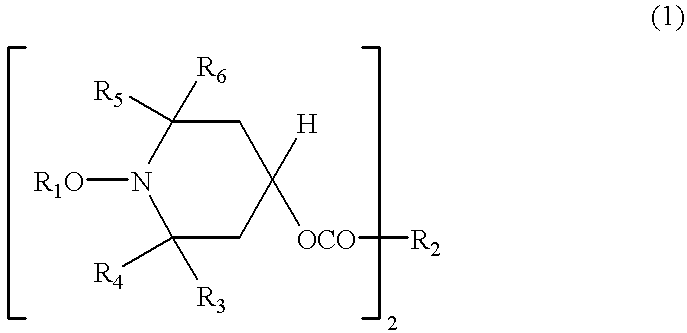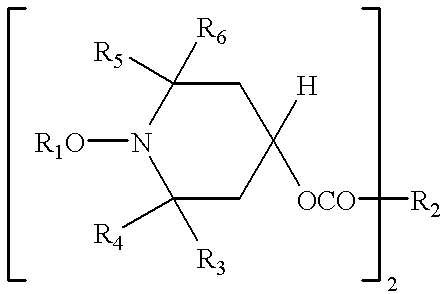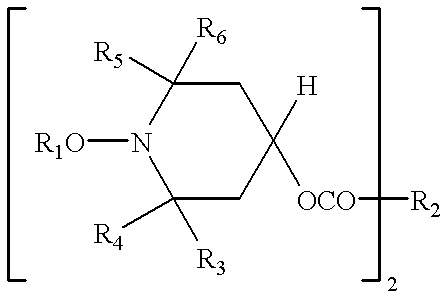Ink jet recording paper and the production thereof
- Summary
- Abstract
- Description
- Claims
- Application Information
AI Technical Summary
Benefits of technology
Problems solved by technology
Method used
Image
Examples
example 1
Preparation of Support
85 parts of LBKP having a Canadian standard freeness of 380 ml; 15 parts of NBKP having a Canadian standard freeness of 500 ml; as a loading material, 15 parts of talc, 0.5 parts of commercially available rosin type of sizing agent, 0.3 parts of commercially available cationized starch, 0.5 parts of aluminum sulfate; and 0.1 parts of commercially available paper strength-reinforcing agent were put into water to prepare a 0.8% in solid slurry, and therefrom a support was made using a Foutdrinier paper machine so that basis weight would be controlled at 130 g / m.sup.2.
Preparation of Coloring Material for Forming Ink-receiving Layer and their Coating
100 parts of synthetic amorphous silica (Finesil X-37B, trade name, produced by Tokuyama Co., Ltd.), 25 parts of polyvinyl alcohol (PVA117, trade name, produced by Kuraray Co., Ltd.), 10 parts of ethylene / vinyl acetate copolymer emulsion (Sumika Flex 401, trade name, produced by Sumitomo Chemical Co., Ltd.), 5 parts of ...
example 2
An ink jet recording paper having a 75 degree specular gloss of 20% was prepared in the same manner as in Example 1 except that both the first and second colloidal silica layers were prepared from a 15% solids slurry, prepared by putting 100 parts of cationic colloidal silica having a particle diameter of 90 nm (SnowTex OUP, trade name, produced by Nissan Chemical Industries, Ltd.), 6 parts of dye-fixing agent (PolyFix 700, trade name, produced by Showa Highpolymer Co., Ltd.), 3 parts of cationic sizing agent (Polymaron 360, trade name, produced by Arakawa Chemicals Co., Ltd.) and 0.2 parts of anti-foaming agent (KM-72F, trade name, produced by Shin-Etsu Chemical Co., Ltd.) into water. Both layers had a coating weight after drying of 2 g / m.sup.2.
example 3
An ink jet recording paper having 75 degree specular gloss of 18% was prepared in the same manner as in Example 1 except that the slurry used for preparing the first colloidal silica layer was replaced by a 15% solids slurry prepared by putting 100 parts of cationic colloidal silica having a particle diameter of 125 nm (SnowTex SO, trade name, produced by Nissan Chemical Industries, Ltd.), 6 parts of dye-fixing agent (PolyFix 700, trade name, produced by Showa Highpolymer Co., Ltd.), 3 parts of cationic sizing agent (Polymaron 360, trade name, produced by Arakawa Chemicals Co., Ltd.) and 0.2 parts of anti-foaming agent (KM-72F, trade name, produced by Shin-Etsu Chemical Co., Ltd.) into water.
PUM
| Property | Measurement | Unit |
|---|---|---|
| Fraction | aaaaa | aaaaa |
| Fraction | aaaaa | aaaaa |
| Linear density | aaaaa | aaaaa |
Abstract
Description
Claims
Application Information
 Login to View More
Login to View More - R&D
- Intellectual Property
- Life Sciences
- Materials
- Tech Scout
- Unparalleled Data Quality
- Higher Quality Content
- 60% Fewer Hallucinations
Browse by: Latest US Patents, China's latest patents, Technical Efficacy Thesaurus, Application Domain, Technology Topic, Popular Technical Reports.
© 2025 PatSnap. All rights reserved.Legal|Privacy policy|Modern Slavery Act Transparency Statement|Sitemap|About US| Contact US: help@patsnap.com



